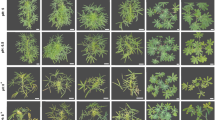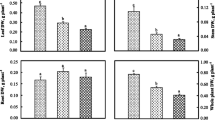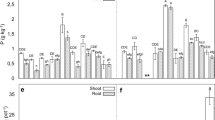Abstract
A soil Ca/Mg quotient greater than unity is generally considered necessary for normal plant growth but some serpentine plants are adapted to much lower Ca/Mg quotients, resulting from a major cation imbalance in their substrata. In order to investigate the growth and tolerance responses of serpentine and non-serpentine species to varied Ca/Mg quotients, controlled nutrient solution experiments were performed using an a newly reported Iranian endemic serpentine plant, Cleome heratensis Bunge et Bien. Ex Boiss. and a related non-serpentine species Cleome foliolosa DC. and a Eurasian Ni-hyperaccumulating species Alyssum murale Waldst. and Kit. Seedlings were grown in modified Hoagland’s solutions with varying Ca and Mg concentrations (0.2–2.5 and 0.5–10 mM, respectively) in a fully factorial randomised block design. The yields of the two serpentine plants increased significantly as Mg concentrations in the nutrient solution were increased from 0.5 to 4 mM but decreased in the 10 mM Mg treatment. For C. foliolosa yields decreased significantly from 0.5 to 10 mM Mg, indicating the sensitivity of this non-serpentine plant, and the relative tolerance of the serpentine plants to extremely high levels of Mg. Shoot and root Mg and Ca concentrations in C. heratensis and A. murale were higher than those in C. foliolosa in the low and moderate Mg treatments, supporting the view that many serpentine plants have a relatively high requirement for Mg. Maximum Mg concentrations were found in the roots of C. heratensis. Yields of C. heratensis and A. murale did not change significantly as Ca levels in nutrient solution increased from 0.2 to 2.5 mM Ca, However the yield of C. foliolosa increased significantly from 0.2 to 1.5 mM Ca, indicating sensitivity in this non-serpentine plant and tolerance of the two serpentine plants to low levels of Ca correlated with tissue Ca concentrations, probably because of a greater ability for Ca uptake at low-Ca availability. Calcium deficiency in the low-Ca treatments could be a reason for reduced yield in the non-serpentine plants.






Similar content being viewed by others
References
Asemaneh T, Ghaderian SM, Baker AJM (2005) Biogeochemical aspects of the Iranian endemic serpentine plant Cleome heratensis (Capparaceae). In: Lombi E et al. (eds) Abstracts of the 8th international conference on the biogeochemistry of trace elements (ICOBTE), Adelaide, South Australia, 3–7 April 2005, pp820–821. CSIRO Land and Water
Asemaneh T, Ghaderian SM, Crawford SA, Marshall AT, Baker AJM (2006) Cellular and subcellular compartmentation of Ni in the Eurasian serpentine plants Alyssum bracteatum, A. murale (Brassicaceae) and Cleome heratensis (Capparaceae). Planta (in press)
Bradshaw HD (2005) Mutations in CAX1 produce phenotypes characteristic of plants tolerant to serpentine soils. New Phytol 167:81–88
Brady KU, Kruckeberg AR, Bradshaw HD (2005) Evolutionary ecology of plant adaptation to serpentine soils. Annu Rev Ecol Evol Syst 36:243–266
Broadley MR, Bowen HC, Cotterill HL, Hammond JP, Meacham MC, Mead A, White PJ (2003) Variation in the shoot calcium content of angiosperms. J Exp Bot 54:1431–1446
Brooks RR (1987) Serpentine and its vegetation. A multidisciplinary approach. Dioscorides Press, Portland, USA, 454pp
Bush DS (1995) Calcium regulation in plant cells and its role in signaling. Annu Rev Plant Physiol Plant Mol Biol 46:95–122
Cakmak I, Hengeler C, Marschner H (1994) Changes in phloem export of sucrose in leaves in response to phosphorus, potassium and magnesium deficiency in bean plants. J Exp Bot 278:1251–1257
Cheng NH, Pittman JK, Bronwyn JB, Shigaki T, Hirchi KD (2003) The Arabidopsis cax1 mutant exhibits impaired ion homeostasis, development, and hormonal responses and reveals interplay among vacuolar transporters. Plant Cell 15:347–364
Demidchik V, Davenport RJ, Tester M (2002) Nonselective cation channels in plants. Annu Rev Plant Biol 53:67–107
Evans DE, Briars SA, Williams LE, Chanson A (1991) Active transport of proton and calcium in higher plant cells. J Exp Bot 42:285–303
Fox TC, Guerinot ML (1998) Molecular biology of cation transport in plants. Annu Rev Plant Physiol Plant Mol Biol 49:669–696
Ghaderian SM, Baker AJM (2006) Geobotanical and biogeochemical reconnaissance of the ultramafics of Central Iran. J Geochem Explor (in press)
Goodwin-Bailey CI, Woodell SRJ, Loughman BC (1992) The response of serpentine, mine spoil and saltmarsh races of Armeria maritima (Mill.) Willd. to each others’ soils. In: Baker AJM, Proctor J, Reeves RD (eds) The vegetation of ultramafic (Serpentine) soils. Intercept Limited, Andover, UK, pp 375–390
Hirschi KD, Zhen RG, Cunningham KW, Rea PA, Fink GR (1996) CAX1, an H+/Ca2+ antiporter from Arabidopsis. Proc Natl Acad Sci USA 93:8782–8786
Kinraide TB (1994) Use of the Gouy-Champan-Stern model for membrane surface electrical potential to intercept some features of mineral rhizotoxicity. Plant Physiol 106:1583–1592
Kruckeberg AR (1984) California serpentines: flora, vegetation, geology, soils and management problems. University of California Press, Berkeley, CA, 180 pp
Lavon R, Goldschmidt EE (1999) Effect of potassium, magnesium, and calcium deficiencies on nitrogen constituents and chloroplast components in Citrus leaves. J Am Soc Hortic Sci 124:158–162
Lombini A, Llugany M, Poschenrieder C, Dinelli E, Barceló J (2003) influence of the Ca/Mg ratio on Cu resistance in three Silene armeria ecotypes adapted to calcareous soil or to different, Ni- or Cu- enriched, serpentine sites. J Plant Physiol 160:1451–1456
Madhok OP, Walker RB (1969) Magnesium nutrition of two species of sunflower. Plant Physiol 44:1016–1020
Main JL (1981) Magnesium and calcium nutrition of a serpentine endemic grass. Am Midl Nat 105:196–199
Miller SP, Cumming JR (2000) Effect of serpentine soil factors on Virginia pine (Pinus virginiana) seedlings. Tree Physiol 20:1129–1135
O’Dell RE, Claassen VP (2006) Serpentine and non-serpentine Achillea millefolium accessions differ in serpentine substrate tolerance and response to organic and inorganic amendments. Plant Soil 279:253–269
O’Dell RE, James JJ, Richards JH (2006) Congeneric serpentine and non-serpentine shrubs differ more in leaf Ca:Mg than in tolerance of low N, low P, or heavy metals. Plant Soil 280:49–64
Parker DR, Norvell WA (1999) Advances in solution culture methods for plant mineral nutrition research. Adv Agron 65:151–213
Parker DR, Norvell WA, Chaney RL (1995) GEOCHEM-PC: a chemical speciation program for IBM and compatible personal computers. In: Loeppert RH (eds), Chemical equilibrium and reaction models. ASA, SSSA Madison, WI, pp 253–269
Parker DR, Pedler JF, Thomson DN, Li H (1998) Alleviation of copper rhizotoxicity by calcium and magnesium at defined free metal-ion activities. Soil Sci Soc Am J 62:965–972
Proctor J (1999) Toxins, nutrient shortages and droughts: the serpentine challenge. Trends Ecol Evol 14:334–335
Proctor J, McGowan I (1976) Influence of magnesium on nickel toxicity. Nature 176:234
Proctor J, Nagy L (1992) Ultramafic rocks and their vegetation: an overview. In: Baker AJM, Proctor J, Reeves RD (eds) The vegetation of ultramafic (Serpentine) soils. Intercept Limited, Andover, UK, pp 469–494
Rajakaruna N, Siddiqi MY, Whitton J, Bohm BA, Glass ADM (2003) Differential responses to Na+/K+ and Ca2+/Mg2+ in two edaphic races of the Lasthenia californica (Asteraceae) complex: a case for parallel evolution of physiological traits. New Phytol 157:93–103
Robertson AI (1985) The poisoning of roots of Zea mays by nickel ions, and protection afforded by magnesium and calcium. New Phytol 100:173–189
Schat H, Vooijs R, Kuiper E (1996) Identical major gene loci for heavy metal tolerances that have independently evolved in different local populations and subspecies of Silene vulgaris. Evolution 50:1888–1895
Shabala S, Hariadi Y (2005) Effects of magnesium availability on the activity of plasma membrane ion transporters and light-induced responses from broad bean leaf mesophyll. Planta 221:56–65
Tibbetts RA, Smith JAC (1992) Vacuolar accumulation of calcium and its interaction with magnesium availability. In: Baker AJM, Proctor J, Reeves RD (eds) The vegetation of ultramafic (Serpentine) soils. Intercept Limited, Andover, UK, pp 367–373
Tyndall RW, Hull JC (1999) Vegetation, flora, and plant physiological ecology of serpentine barrens of eastern North America. In: Anderson RC, Fralish JC, Baskin JM (eds) Savanna, barrens, and rock outcrop plant communities of North America. Cambridge University Press, Cambridge, UK, pp 67–82
Acknowledgements
A scholarship to the senior author from the Ministry of Science, Research and Technology of Iran (MSRT) and Yasuj and Isfahan Universities is gratefully acknowledged.
Author information
Authors and Affiliations
Corresponding author
Rights and permissions
About this article
Cite this article
Asemaneh, T., Ghaderian, S.M. & Baker, A.J.M. Responses to Mg/Ca balance in an Iranian serpentine endemic plant, Cleome heratensis (Capparaceae) and a related non-serpentine species, C. foliolosa . Plant Soil 293, 49–59 (2007). https://doi.org/10.1007/s11104-006-9147-7
Received:
Accepted:
Published:
Issue Date:
DOI: https://doi.org/10.1007/s11104-006-9147-7




